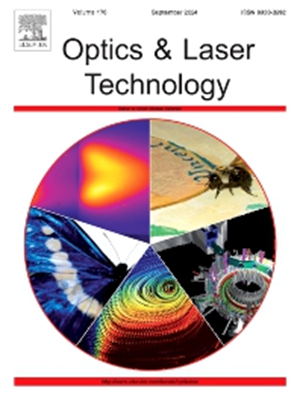Multiplexing technique using photodetector arrays for quasi-distributed intensity variation optical fiber sensors system
IF 4.6
2区 物理与天体物理
Q1 OPTICS
引用次数: 0
Abstract
This paper presents the development and characterization of a multiplexing technique for quasi-distributed optical fiber sensors based on the intensity variation detection. The technique is based on an array of photodetectors coupled to the optical fiber, where each lateral section of the optical fiber is analyzed as a sensor along the optical fiber cable. In this case, the polymer optical fiber (POF) is used due to its higher diameter and higher flexibility, which leads not only to easier coupling between the photodetector and the fiber, but also higher sensitivity for mechanical parameters detection. The proposed technique is tested under two configurations. In the first one, two sensors are developed in a single POF cable for curvature detection along the optical fiber, where the results indicated the feasibility of using such sensors to detect the curvature position at 4 different regions along the POF with a root mean squared error (RMSE) as small as 0.49 cm. Then, a 4 sensor array is developed for simultaneous force and position detection along the optical fiber, where the results indicated relative errors below 5 % on the force amplitude and position detection. Therefore, the quasi-distributed intensity variation sensors can be readily used in shape reconstruction applications, which can be integrated not only in different flexible structure, but also in textiles for wearable sensors for health monitoring and biomechanics assessment.
求助全文
约1分钟内获得全文
求助全文
来源期刊
CiteScore
8.50
自引率
10.00%
发文量
1060
审稿时长
3.4 months
期刊介绍:
Optics & Laser Technology aims to provide a vehicle for the publication of a broad range of high quality research and review papers in those fields of scientific and engineering research appertaining to the development and application of the technology of optics and lasers. Papers describing original work in these areas are submitted to rigorous refereeing prior to acceptance for publication.
The scope of Optics & Laser Technology encompasses, but is not restricted to, the following areas:
•development in all types of lasers
•developments in optoelectronic devices and photonics
•developments in new photonics and optical concepts
•developments in conventional optics, optical instruments and components
•techniques of optical metrology, including interferometry and optical fibre sensors
•LIDAR and other non-contact optical measurement techniques, including optical methods in heat and fluid flow
•applications of lasers to materials processing, optical NDT display (including holography) and optical communication
•research and development in the field of laser safety including studies of hazards resulting from the applications of lasers (laser safety, hazards of laser fume)
•developments in optical computing and optical information processing
•developments in new optical materials
•developments in new optical characterization methods and techniques
•developments in quantum optics
•developments in light assisted micro and nanofabrication methods and techniques
•developments in nanophotonics and biophotonics
•developments in imaging processing and systems

 求助内容:
求助内容: 应助结果提醒方式:
应助结果提醒方式:


